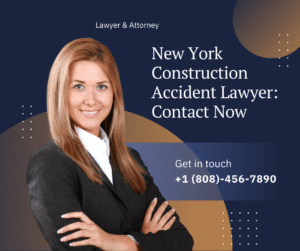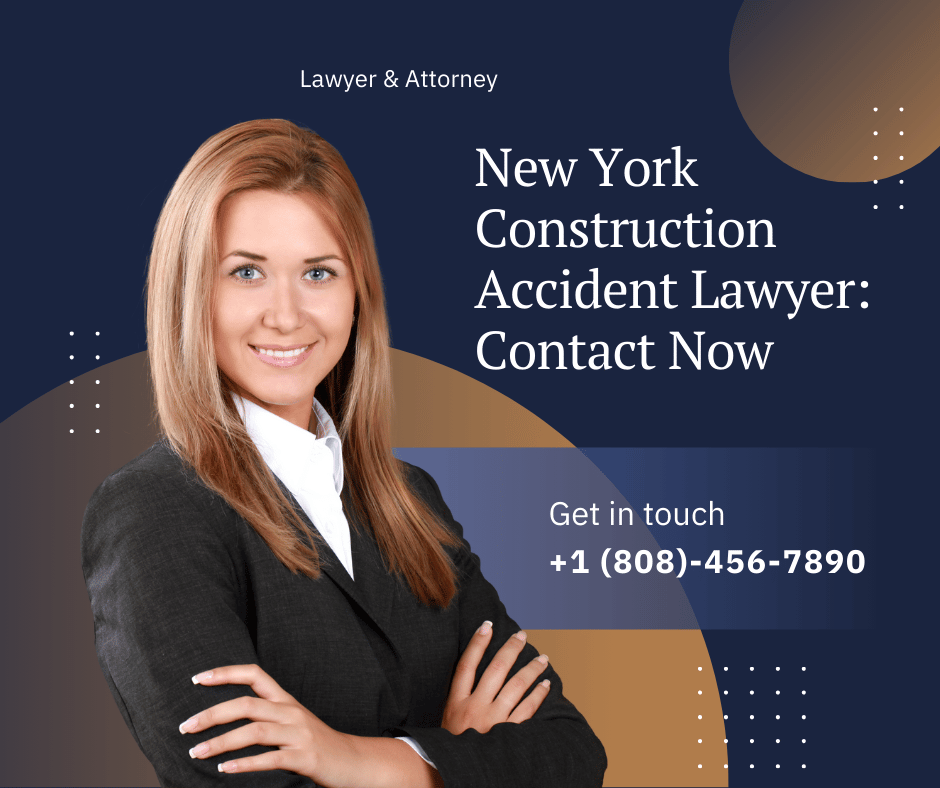Construction sites are inherently dangerous environments. Workers are exposed to numerous risks daily, from working with heavy machinery and high structures to handling hazardous materials. Accidents can happen in the blink of an eye, leading to serious injuries or even fatalities.
If you or a loved one has been injured in a construction accident in New York, it’s important to understand your rights and options.
In this guide, we will explore the role of a New York construction accident lawyer, how to choose the right attorney, the steps involved in a construction accident case, and the potential compensation you may be entitled to. Let’s dive in.
What Is a Construction Accident Lawyer?

A construction accident lawyer specializes in handling cases related to accidents that occur on construction sites. These lawyers represent workers, contractors, subcontractors, or even third parties who have been injured on construction sites due to negligence or unsafe working conditions.
Construction accident lawyers are highly skilled in personal injury law, particularly in the complexities surrounding worker’s compensation, third-party claims, and other construction-related legal issues.
What Types of Accidents Do They Handle?
Construction accidents can vary widely depending on the work environment, the tools used, and the types of construction involved. Some of the most common types of construction accidents that lawyers deal with include:
Falls from Heights: These are the most common and often the most serious type of construction accident. Workers may fall from scaffolding, ladders, roofs, or other elevated surfaces.
Falling Objects: Construction workers can be injured if tools, debris, or materials fall from heights or scaffolding.
Electrocution: Construction workers may suffer serious injuries or death due to exposed wires, faulty electrical equipment, or improper use of electrical tools.
Machinery Accidents: Heavy machinery like cranes, bulldozers, and forklifts can cause severe injuries if not operated correctly or if safety precautions are not followed.
Lifting and Repetitive Motion Injuries: Construction workers often lift heavy materials or perform repetitive motions, which can result in strains, sprains, and long-term musculoskeletal injuries.
Vehicle Accidents: Construction zones often involve a lot of heavy vehicle traffic, leading to accidents involving trucks, construction vehicles, or other machinery.
Toxic Exposure: Construction workers may be exposed to dangerous chemicals, asbestos, or other hazardous materials, resulting in serious illnesses.
Burns: Accidents involving fires or explosions on construction sites can cause severe burns.
Importance of Hiring a New York Construction Accident Lawyer
If you’ve been involved in a construction accident, hiring a specialized lawyer is essential for several reasons:
Expertise in Construction Law
New York construction law is complex, with strict safety regulations imposed by federal and state agencies. A construction accident lawyer will have in-depth knowledge of these laws, including OSHA regulations, New York Labor Law, and worker’s compensation rules.
Protection of Your Rights
A lawyer ensures that your rights are protected throughout the claims process. They will advocate for you, ensuring you receive the proper compensation, whether through worker’s compensation, a third-party lawsuit, or both.
Thorough Investigation
Construction accidents often involve multiple parties, including contractors, subcontractors, property owners, and equipment manufacturers. A construction accident lawyer will conduct a thorough investigation to determine the cause of the accident and identify liable parties.
Maximizing Compensation
A skilled lawyer will help you pursue the maximum compensation you are entitled to, considering not only medical bills and lost wages but also pain and suffering, long-term disability, and any potential future expenses related to your injury.
Common Causes of Construction Accidents in New York
Construction accidents often happen due to negligence or failure to follow safety protocols. Some of the common causes of construction accidents include:
1. Negligence of Property Owners
Property owners are responsible for maintaining a safe working environment. If a property owner fails to ensure that the construction site is safe, they may be held liable for any resulting accidents.
2. Poor Equipment Maintenance
Heavy machinery and tools must be properly maintained and regularly inspected. If they are malfunctioning or improperly used, it can lead to accidents. If the manufacturer or equipment provider is at fault, you may have grounds for a lawsuit.
3. Failure to Follow Safety Protocols
Construction sites are governed by strict safety regulations. When employers, supervisors, or workers ignore these regulations, it can lead to serious accidents. The failure to use safety equipment, maintain proper scaffolding, or secure hazardous materials are common violations.
4. Unsafe Working Conditions
Construction sites are often crowded, with hazardous materials, machinery, and heavy traffic. Poor site management and lack of safety barriers, proper lighting, or warning signs can lead to accidents.
5. Lack of Proper Training
If workers are not properly trained on how to use equipment or follow safety protocols, accidents are more likely to occur.
The Legal Process: Steps to Take After a Construction Accident
If you’ve been injured in a construction accident in New York, there are several important steps to take to protect your rights and begin the claims process:
1. Seek Medical Attention
Your health and well-being should be your top priority. Seek immediate medical attention, even if your injuries seem minor at first. Some injuries, like concussions or internal injuries, may not be immediately obvious.
2. Report the Accident
Notify your employer or the site supervisor about the accident. This will help document the incident and ensure that it is properly investigated.
3. Collect Evidence
If possible, gather evidence at the scene of the accident. This may include photographs of the accident site, witness statements, safety violations, and any other relevant information.
4. Consult a Construction Accident Lawyer
Consult a qualified New York construction accident lawyer as soon as possible. They will help you understand your legal rights, review the details of your case, and guide you through the process of filing a claim.
5. File a Worker’s Compensation Claim
In New York, most construction workers are entitled to file a worker’s compensation claim. This is a no-fault system that provides benefits to injured workers, regardless of who was at fault for the accident. Worker’s compensation can cover medical bills, lost wages, and rehabilitation costs.
6. Pursue Third-Party Claims
In some cases, workers may also pursue third-party claims against other parties responsible for the accident, such as contractors, equipment manufacturers, or property owners. Your attorney can help determine if a third-party lawsuit is appropriate in your case.
Types of Compensation You May Be Entitled to
The compensation you may be entitled to after a construction accident will depend on several factors, including the nature of the accident, the extent of your injuries, and the parties involved. The most common types of compensation include:
1. Medical Expenses
This includes costs for hospital stays, surgeries, medications, physical therapy, and any other medical treatment related to your injuries.
2. Lost Wages
If you are unable to work due to your injuries, you may be entitled to compensation for lost wages and future earning potential.
3. Pain and Suffering
This compensates you for the physical pain, emotional distress, and loss of enjoyment of life caused by the accident and your injuries.
4. Disability
If your injuries result in permanent disability, you may be entitled to compensation for long-term disability, including the costs of any adaptive equipment or home modifications you may need.
5. Punitive Damages
In cases where the defendant’s actions were particularly reckless or intentional, you may be entitled to punitive damages in addition to compensatory damages.
Choosing the Right Construction Accident Lawyer in New York
When selecting a construction accident lawyer, it’s important to consider several factors:
1. Experience
Look for a lawyer who has extensive experience in handling construction accident cases. They should be familiar with New York’s construction laws and the complexities of these types of cases.
2. Track Record of Success
Choose a lawyer with a proven track record of success in obtaining favorable settlements and verdicts for clients in similar cases.
3. Reputation
Read client reviews, testimonials, and any professional recognition the lawyer has received. A good reputation can indicate a lawyer’s reliability and commitment to their clients.
4. Personal Attention
Ensure that the lawyer will give personal attention to your case and keep you updated throughout the process.
5. Free Consultation
Many construction accident lawyers offer free consultations. Use this opportunity to discuss your case, evaluate the lawyer’s expertise, and determine if they are the right fit for you.
Conclusion
Construction accidents in New York can be devastating, but with the help of a skilled construction accident lawyer, you can navigate the legal process and ensure you receive the compensation you deserve. Whether you are pursuing a worker’s compensation claim or a third-party lawsuit, an experienced attorney will guide you through the complexities of construction accident cases and protect your rights. If you or a loved one has been injured on a construction site, don’t hesitate to seek legal counsel today.

